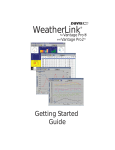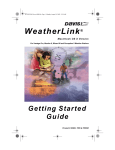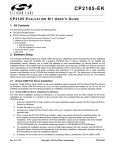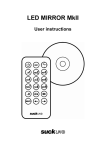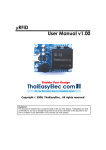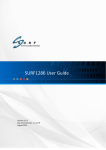Download DAVIS Energy WeatherLink Troubleshooting guide
Transcript
For Davis weather stations including Vantage Pro2™, Vantage Vue™ Weather Envoy™, and Vantage Pro® $AVIS)NSTRUMENTS$IABLO!VENUE(AYWARD#!53!ssWWWDAVISNETCOM FCC Part 15 Class B Registration Warning This equipment has been tested and found to comply with the limits for a Class B digital device, pursuant to Part 15 of the FCC Rules. These limits are designed to provide reasonable protection against harmful interference in a residential installation. This equipment generates, uses and can radiate radio frequency energy and, if not installed and used in accordance with the instructions, may cause harmful interference to radio communications. However, there is no guarantee that interference will not occur in a particular installation. If this equipment does cause harmful interference to radio or television reception, which can be determined by turning the equipment on and off, the user is encouraged to try to correct the interference by one or more of the following measures: • Reorient or relocate the receiving antenna • Increase the separation between the equipment and receiver • Connect the equipment into an outlet on a circuit different from that to which the receiver is connected • Consult the dealer or an experienced radio/TV technician for help. Changes or modifications not expressly approved in writing by Davis Instruments may void the user’s authority to operate this equipment. EC EMC Compliance This product complies with the essential protection requirements of the EC EMC Directive 2004/108/EC; Low Voltage Directive 2006/95/EC; and Eco-Design Directive 2005/32/EC> 0.5 watt no-load adapter. Product Number: 6520 Part Number: 7395.280 Rev. D August 26, 2009 ® WeatherLink for Vantage Pro, Vantage Pro2, & Vantage Vue, Mac OS X Version Vantage Pro and WeatherLink, are registered trademarks of Davis Instruments Corp. Vantage Pro2, Vantage Vue and Weather Envoy are trademarks of Davis Instruments Corp. Hayes is a registered trademark of Hayes Microcomputer Products, Inc. Macintosh is a trademark of Apple Computer Corporation. © 2009 Davis Instruments Corp. All rights reserved. Information in this document is subject to change without notice. 3465 Diablo Avenue, Hayward, CA 94545-2778 U.S.A. 510-732-9229 • Fax: 510-732-9188 E-mail: [email protected] • www.davisnet.com Contents of Package Welcome to WeatherLink! Welcome to Davis Instruments’ WeatherLink™ for Macintosh OS X. The WeatherLink software and data logger allow you to connect your Apple Macintosh computer running OS X to a Davis weather station so you can store, view, plot, analyze, export, print, and put on the Internet the weather data collected by your station. Contents of Package Before continuing, please make sure your WeatherLink package contains the following listed items: • USB Data Logger • 8' (2.4 m) cable with connector to link your station to your computer. • WeatherLink software CD ROM Hardware Installation You can connect a computer directly to your weather station using the WeatherLink data logger (local connection), or you can connect a computer to a remote weather station using a phone modem (remote connection). Requirements and installation for each type of connection differ, and are explained separately below. Hardware Requirements The hardware requirements for local and remote connections are listed below. Local Connection Hardware Requirements In addition to the provided hardware, the following are required for a direct connection. • Macintosh computer running OS X v10.1 or newer with at least 5 MB of free disk space. The amount of space necessary for the data files depends on the archive interval. Database files containing data stored at a 30 minute archive interval require approximately 36K of disk space per month of data. The file size changes in a linear fashion depending on the archive interval. For example, data stored at a 1–minute interval requires approximately 1 MB/month while the data stored at a 2–hour interval requires approximately 9K/month. • One free USB port 1 Connecting Vantage Pro, Vantage Pro2, or Vantage Vue Console Remote Connection Hardware Requirements In addition to the provided hardware and the computer equipment listed above, the following hardware is required for a phone modem connection. • One external modem to connect to the data logger at the remote site. • One internal or external modem connected to your Macintosh computer • Telephone Modem Adapter - The Telephone Modem Adapter is specially wired to provide the connection between the data logger and the modem. Use a #6533 adapter. Connecting Vantage Pro, Vantage Pro2, or Vantage Vue Console The instructions below explain how to connect your Vantage Pro, Vantage Pro2, or Vantage Vue console directly to your computer. Complete the local USB connection by using the instructions below. Note: For Weather Envoy, see your Envoy Manual for instructions on how to install the data logger and connect to the computer. 1. Enter the console’s Setup Mode by pressing and holding DONE, then pressing the down arrow (-). Entering Setup Mode ensures that the station is not writing any data and saves the current daily weather information to memory. 2. Remove the battery cover from the console and remove all power by removing the batteries and AC-power adapter, if present. Note: Failure to remove power to the console before installing the data logger may cause damage to the data logger or console. Plugging or unplugging the data logger while power is applied can lock up or damage the logger. 3. Firmly insert the USB data logger into the large receptacle marked EXPANSION inside the battery compartment. 4. Guide the data logger cable through the square slot below the receptacle. 5. Restore power to the console by reinstalling the batteries and reattaching the power adapter, if present. The console beeps three times in Vantage Pro, four times inVantage Vue; each beep occurs within one second of the others. 6. Replace the battery cover, ensuring that the data logger cable exits through the square slot. 7. Locate a free USB port on your computer and connect the USB connector to the port. 2 Remote Modem Connection Notes 8. Insert the USB - Mini B connector on the USB connector of the USB data logger. The connection between the console and the computer can be extended up to 16’ (5 m) using a USB-to-USB connector cable. Vantage Pro Console Vantage Vue Console Battery Cover Data Logger Battery Cover USB port USB-mini B Cable Typical Local Connection for Vantage Pro, Vantage Pro2 and Vantage Vue 9. Check the Baud rate settings on the console. • Enter the console Setup Mode by pressing and holding DONE key, then pressing the DOWN arrow (-) key on your console. • Use DONE and BAR to scroll to the Baud Rate screen. The Baud Rate setting here on the console must be same as that set in the WeatherLink software. • Use the UP (+) and DOWN arrow (-) keys to change the baud rate setting, if needed. • Press and hold DONE to exit Setup Mode. • The default setting is 19200 Baud. Remote Modem Connection Notes When accessing a remote modem connection, WeatherLink automatically dials the station and console whenever an action has been performed in the software that requires it to talk to the station. While connected to a remote station, an On-Line icon displays in the toolbar. This icon indicates that WeatherLink has established a connection with the remote console and weather station. Select the On-Line icon from the 3 Installing the Software toolbar or select Hang Up from the File menu to disconnect the phone connection. On-Line (Hang Up) Toolbar with On-Line Icon By default, WeatherLink hangs up the connection to the modem after one minute without any communication with the station. Use the Communications Port dialog box in the Setup menu of WeatherLink to change this default value. (See the WeatherLink help files for more information.) Note: WeatherLink does not hang up the phone line if the bulletin, summary, or other windows receiving real-time data from the console are active. Software Installation and Setup It is easy to install and setup WeatherLink on your computer once the connection to your console has been configured. Walk through the following section to setup and configure your WeatherLink software and the connection to your console. Installing the Software 1. Place the Install Disk in your CD ROM drive. 2. Double click on the package file, "WeatherLink 5.1.mpkg." Note: Your version number may be different. 3. Follow the on-screen prompts to complete the installation. Optional: Installing USB drivers Specialized USB drivers must be installed when you connect a Vantage Pro, Vantage Pro2, Envoy, or Vantage Vue to your Mac via a USB connection. Once you have installed WeatherLink, but before you open the program, install the specialized drivers that come on the Installation CD. 1. Open the USB installer package (the folder marked Davis USB Datalogger Drivers) located on the Install disk. 2. Run “SLAB_USBtoUART Installer”. The necessary USB drivers install and you are prompted to restart your computer. 3. Restart your computer. 4. When the Communications Configuration dialog box displays, select SLAB_USBtoUART as your port. 4 Running the Software Running the Software To run the software, double-click the WeatherLink icon. If no stations have been assigned in the program directory, the software prompts you to add a station (see below for details). If there is more than one station in the program directory when the application opens, the last station that was displayed is automatically opened. Station Setup Each station connected to the computer must have its own station within the software. This tells the software which database to store the new data, provides the necessary communication settings (serial port, baud rate, etc.), and explains other station-specific information. Adding a Station 1. Select New Station from the File menu. The New Station dialog box displays. 2. Type the desired station name (up to 40 characters/spaces) into the Station Name text box. The software uses the first eight characters of the station name (not counting spaces or punctuation marks) as the name of the directory into which it saves this station’s database and configuration files. The first eight characters of each station name must, therefore, be unique. 3. Click OK to save the new station or click Cancel to exit without saving. The software saves the new station, creates a directory and a configuration file for the station, and prompts you to enter the walk-through procedure. About the Walkthrough The software includes a station setup walkthrough that steps you through the weather station configuration procedures. After adding a new station, the Walkthrough dialog box automatically displays. By selecting Yes, the walkthrough process begins. By selecting No, the Walkthrough process is exited. You can set up and configure your station by separately selecting all of the necessary setup options from the Setup menu. A Walkthrough option is included in the Setup menu that allows you to access the Walkthrough at any time. Note: When necessary, the software automatically dials a phone modem station. By selecting the Walkthrough process, the software displays a series of dialog boxes. At each step in the Walkthrough process, confirmation boxes are provided to perform or skip the next step in the Walkthrough. To continue, select OK. To skip this step and move to the next step, select Skip. To cancel the entire walkthrough process, select Cancel. Note: Please refer to the WeatherLink Help for more information about the Walkthrough and about the different setup options. 5 Troubleshooting Guide Communication Configuration Settings WeatherLink contains a dialog box for locating the communications port (either USB or serial) that the data logger and console are connected to. Use the Communications Configuration dialog box to select the communications port that is used to communicate with the console. 1. Select Communications Port from the Setup menu or use the Walkthrough to display the dialog box. The Communications Configuration dialog box displays. The correct driver should display automatically in the Port drop down box. 2. Click OK to save the correct communications configuration setting. Troubleshooting Guide Please consult this guide and the on-line help files before contacting Technical Support. Communications Problems If you are having trouble establishing communication between the weather station and WeatherLink, start by checking the console's own diagnostics. Remove all power to the console and restart it by restoring power (with the data logger still attached). Note: The data logger uses non-volatile memory, so you won’t lose any data you’ve already recorded. However, make sure to put the console in Setup Mode by pressing and holding the [DONE] key, then pressing the [-] key before removing the batteries. This ensures the station will not try to write any data as the power goes off. • The console will emit a series of beeps. (Two for Envoy, three for Vantage Pro and Pro2, four for Vantage Vue). Each beep indicates that the weather station has passed one of its diagnostic tests. Note: Make sure the data logger is plugged in firmly. If you hear one fewer beep than you should, this indicates that the console or Envoy does not sense the data logger. • If the console or Envoy emits the correct number of beeps, but you are still having trouble, see Communication Configuration Settings on page 6 for instructions on checking standard port settings. If the port settings test process identifies a serial port other than the one selected in station setup, try connecting to the data logger again. • Check the serial port adapter if using a serial port connection. Older model adapters, or models not supplied in the WeatherLink connection kit, are not compatible. • Check the Baud Rate setting on the console and in the Communication Port dialog box in the software. Make sure they have the same number. Enter the console’s Setup Mode by pressing and holding DONE, then 6 Communications Problems pressing the down arrow (-) on the console. Scroll through the setup choices by pressing the [BAR] or [DONE] keys until you reach the Baud Rate screen. This screen only appears if the data logger is plugged into the console. Checking the Communications Port The WeatherLink software includes a procedure for testing the communications port to which your station is connected. Using the Test command will help you determine whether the communications port or the data logger is causing a communication problem. 1. Select Communications Configuration from the Setup menu. The Communications Configuration window displays. 2. In the upper drop-down list of the Port section of the window, select the port you want to test. The port shown in the pull-down list should be “SLAB_USBtoUART.” 3. Click Test. The software searches all standard USB ports and should display a Please Note window stating the COM port at which the USB connector is located. 4. If WeatherLink cannot find the USB connector at any COM port, an error message displays, stating “No station could be found.” If this error message window displays, contact Davis Technical Support (see “Contacting Davis Technical Support” on page 9 for more information). 7 Program Problems Program Problems The barometer graph on the Bulletin does not “fill in” completely. When you first load the bulletin, the barometer graph will only fill in completely when you have data in your database for the last six hours. Make sure of the following: • There is data in your database for the span of the barometer graph. • The time and date of the stored barometer data is correct in your database. • The time and date on the PC is correct. • The time and date on the weather station are correct. I have duplicate records in my database. Why? If you do not download from the data logger prior to changing the weather station’s time and date (for a Daylight Savings time change, for example), you may get duplicate records. Make sure to download before setting time and date. In addition, you should be aware that the midnight records are duplicated so they appear in each consecutive day. For example, a midnight record would appear at the end of the data for November 22 and at the start of the data for November 23. Using the record editor to change the record in one day does not change the record in the other day. Note: Do not delete duplicate midnight records; it may affect the rain database or NOAA monthly summary. No wind direction reading (or dashes instead of a reading) appears in my database. Be aware that if there is no wind speed when the direction is being sampled, wind direction is not recorded. During intervals with very little wind speed, no direction may be recorded. Note: Since high wind speed is sampled more often, it is possible to have a high wind speed but no wind speed or direction. WeatherLink says “No new data to download” but I know there’s data there. What can I do? Vantage is smart enough to send only data it hasn’t already sent to the computer. So, when you initiate a new download, the program will retrieve the first record after the last record shown in the WeatherLink’s Browse Window. Older data is stored in the logger as a backup. To see how many of these backup records are stored in the logger, create a new station and download the data into this new database. Because there are no records stored in the station you just created, WeatherLink will download everything it has stored. Next, try clearing the archive memory using the clear dialog box. You will lose any data not already downloaded in your archive memory, but all of your calibration numbers and alarm settings will remain intact. If this doesn’t work, reboot your weather station (that is, remove, then restore all power to the station). 8 Contacting Davis Technical Support Note: Make sure to put the console in Setup Mode (by pressing the DONE and DOWN arrow keys) before removing the batteries. This ensures the station will not try to write any data when the power goes off. After successfully downloading, recent or new data does not appear to be in my database. Where is it? Check to see if the time and date on your station are incorrect. (This can happen if you have a power outage and your battery backup is dead.) If so, the data was written into the wrong month, day, and/or time. Reset the time and date. It is also possible, if you have multiple stations, that you downloaded data into the wrong station’s database. Make sure you’ve opened the correct station before downloading. Your data logger may be not be operating properly. If this is the case, you can restore proper operation by repowering the data logger: 1. Remove power from the data logger by removing power from the weather station console. 2. Remove or disconnect the data logger from the console. 3. Wait at least one minute. 4. Connect the data logger to the weather station console. 5. Apply power to the console. 6. If you can now download and see the data in WeatherLink you have fixed the problem. If not, please contact Technical Support for assistance. When viewing data, dashes appear in place of a value for functions other than wind direction. Why? If no data was recorded by a sensor (for example, the sensor was disconnected or radio interference blocked reception) or if bad data was recorded for a sensor (for example, the sensor was malfunctioning), the software dashes out the entry rather than showing invalid data. You can use the record editor to correct these entries. Contacting Davis Technical Support If you have questions about the software, or encounter problems installing or operating the WeatherLink software, please contact Davis Technical Support. (510) 732-7814 – Monday – Friday, 7:00 a.m. – 5:30 p.m. Pacific Time. [email protected] – E-mail to Technical Support. (510) 732-9229 – For callers outside the USA or Canada. (510) 670-0589 – Fax. www.davisnet.com – Copies of User Manuals are available on the “Support” page. Watch for FAQs and other updates. [email protected] – General e-mail. 9 Toolbar Icons Open Station Download Bulletin Window Plot Window Strip Chart Window Yearly Rainfall Database Window On-Line (Hang Up) This MonthÕs NOAA Summary View Help Print Window Exit Program Hot Keys Main Program Window Strip Chart Window Ctrl-A . . . . . .Set Alarms ESC . . . . . . . Halt redraw Ctrl-B . . . . . .View Bulletin Ctrl-M . . . . . Make Default Ctrl-C . . . . . .Station Configuration Ctrl-P . . . . . . Print Strip Chart Ctrl-G . . . . . .Degree-Days Report F1 . . . . . . . . . Context-Sensitive Help Ctrl-H . . . . . .Hang Up F3 . . . . . . . . . Zoom In Ctrl-I . . . . . . .Serial Port Settings F4 . . . . . . . . . Zoom Out Ctrl-J . . . . . .Automatic Download Ctrl-K . . . . . .Walkthrough Ctrl-L . . . . . .Download Ctrl-O . . . . . .Open Station Ctrl-P . . . . . .Print Active Window Ctrl-Q . . . . . .Open Plot Window Ctrl-R . . . . . .Yearly Rain Report Ctrl-S . . . . . .Open Strip Charts Ctrl-T . . . . . .Set Time Ctrl-U . . . . . .Select Units Ctrl-V . . . . . .View Download Log Ctrl-W. . . . . .Browse Database Plot Window ESC . . . . . . . Halt redraw Ctrl-D . . . . . . Choose Date Ctrl-M . . . . . Make Default Ctrl-P . . . . . . Print Plot F1 . . . . . . . . . Context-Sensitive Help F3 . . . . . . . . . Zoom In F4 . . . . . . . . . Zoom Out F9 . . . . . . . . . Overlay Plots F10 . . . . . . . . Last Year Plot Database Window Ctrl-X . . . . . .Auto Fax Settings Ctrl-D . . . . . . Choose Date Ctrl-Y . . . . . .View Summary Ctrl-N . . . . . . Add Note Ctrl-Z . . . . . .Close Window Ctrl-P . . . . . . Print Records F1 . . . . . . . . .Context-Sensitive Help Enter . . . . . . Edit Record F2 . . . . . . . . .Sunrise/Sunset Report Delete . . . . . Delete Record F7 . . . . . . . . .NOAA This Month F1 . . . . . . . . . Context-Sensitive Help F8 . . . . . . . . .NOAA This Year Yearly Rainfall Window Enter . . . . . . Edit Year Delete . . . . . Delete Year












